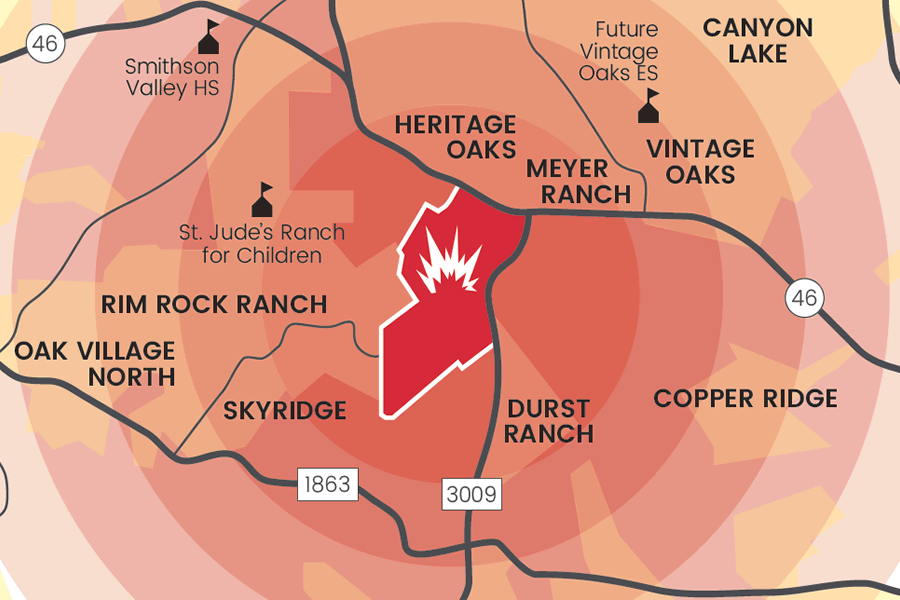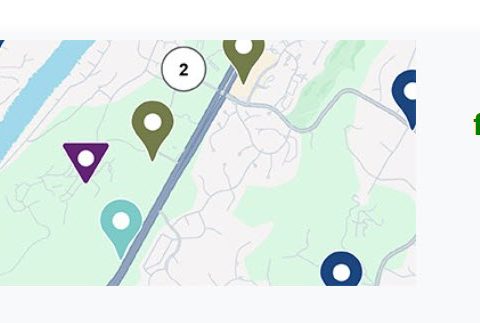by Milann Guckian
President, nonprofit Preserve Our Hill Country Environment
Volunteering to help protect our Hill Country is not the post-retirement job I asked for—but one I felt I must undertake.
Born in Lockhart, my family’s roots are embedded here in the Texas Hill Country. We had a vacation home on Canyon Lake where I spent many a day relishing the beauty of the hills, the rivers and lakes, the wildlife, and the peacefulness that came with these natural wonders.
In 1996, we found our little slice of paradise here in Comal County. We purchased five acres of land surrounded by all that I had come to associate with the Hill Country. We would be nestled amongst oak, cedar, and elm trees with an abundance of wildlife, birds, bats, and insects. Our neighbors to the southeast were our best friends, to the north-northeast sat a 600-acre family homestead, and to the west-northwest sat the beautiful White Ranch.
We planned, we scrimped, and we saved. Then, in 2016, we completed construction of our forever home. Unfortunately, a year later, the White Ranch was sold to Blue Pine Holdings, LLC—a shell company owned by Alabama-based Vulcan Construction Materials. Vulcan plans to turn the White Ranch into an open-pit limestone quarry and mine.
The White Ranch, 1,500 acres (2.3 square miles) of pristine Texas Hill Country rangeland, sits in the middle of Comal County amidst caves, streams, and wildlife.
The ranch sits under the migratory paths of bats, monarch butterflies and whooping cranes. Numerous legacy ranches and homesteads surround the property, many featuring Native American remains, artifacts, caves, and caverns. The property extends southwest nearly three miles from the corner of State Highway 46 and Farm-to-Market 3009.
This land is one of the largest pieces of undeveloped property in the county and is in unincorporated territory a few miles south of Canyon Lake. Of the utmost concern, White Ranch rests entirely over the Edwards Aquifer Recharge Zone (EARZ).
Comal County is one of many counties sitting along the Balcones Escarpment — a significant karst formation in Central Texas. Karst is a terrain formed by dissolution of bedrock — in our area this bedrock is limestone.
The common features of limestone bedrock are sinkholes, caves (such as Natural Bridge Caverns and Bracken Bat Cave), streams and rivers (both underground and above ground), and aquifers. Precipitation provides the groundwater that feeds the karst aquifer system.
The water flows downward through millions of cracks and crevices into underground streams and aquifers. Some of this water reappears at the surface in the form of springs (Comal, Hueco, San Marcos), which feed rivers such as the Comal, San Marcos, and Guadalupe.
Not only does the White Ranch sit atop the EARZ, but the West Fork Dry Comal Creek runs through it, converging downstream with the Dry Comal Creek before flowing into the Comal River, in New Braunfels.
The clear, fresh waters of the Comal River are widely used for recreational swimming and tubing activities. Dry Comal Creek, the Comal River, and the Guadalupe River are essential natural resources in Comal County, supporting economic development and recreation in the county, as well as agricultural operations and wildlife throughout the area.
Comal County has numerous waterways – Dry Comal, Cibolo, Rebecca, and Honey creeks; Comal and Guadalupe rivers; Comal and Hueco springs; the Trinity and Edwards aquifers; and Canyon Lake. Each of these water systems has a bearing on the other. The Dry Comal Creek and Comal River watersheds are also experiencing rapid urbanization, which adds another basis of pollution.
Karst is vulnerable to pollution and the many features — creeks, streams, aquifers, and caves — have interconnected relationships. If any of these water sources become polluted or is irreparably harmed, the others are in danger as well.
White Ranch, by its very location, is a notable component of the EARZ, and the Dry Comal Creek and Comal River drainage basins. A quarry sitting in the middle of all these water resources would present numerous challenges to these many interlinked systems, leaving our community exposed to water quality and quantity sustainability issues.
In 2017, Vulcan applied for an air quality permit with the Texas Commission on Environmental Quality (TCEQ). Area residents banded together to create an all-volunteer grassroots organization to contest the scientific and factual validity of the permit. Preserve Our Hill Country Environment (PHCE) and PHCE Foundation (DBA Stop 3009 Vulcan Quarry and Friends of Dry Comal Creek) were born.
In 2018, TCEQ held a public meeting at the New Braunfels Civic/Convention Center. Over 500 residents, local and state leadership, and media showed up to support our efforts, voice their concerns, and submit public comments for the record.
In March 2019, the contested case hearing process opposing Vulcan’s air permit begin with a preliminary hearing. There was standing room only in the Comal County Courthouse when the administrative law judge (ALJ) extended the affected party boundary from one to five miles and granted affected party status to all who had requested it.
In June 2019, the two-day contested case hearing, similar to a civil trial, was held in Austin. Following the hearing, ignoring the concerns of hundreds of citizens, the ALJ recommended that TCEQ grant the air permit for Vulcan’s quarry.
In November 2019, TCEQ commissioners granted the air permit. We filed a motion for rehearing on the permit, citing the judge’s lack of consideration of the negative impact that the quarry would have on air pollution. We also opposed the “trade secret” excuse claimed by Vulcan and allowed by the ALJ related to Vulcan’s composite core sample used to determine silica content of the mining materials. The rehearing was not granted.
As a result, in February 2020, we had no choice but to sue TCEQ in Travis County District Court. We asked the court to reevaluate the permit, noting that the agency ignored important environmental data and made legal errors when it approved the quarry permit.
In March 2021, citizens groups won an unprecedented victory when Judge Gamble struck down Vulcan’s air permit, reversing and vacating it. Unsurprisingly, TCEQ and Vulcan then appealed that reversal to the Third Court of Appeals.
The property’s future is now in the hands of Texas courts.
TCEQ chose to stand with an out-of-state aggregate behemoth rather than help protect Texas citizens. They issued the permit without adequately considering the impacts on the environment, our natural resources, and the health of the community, as required by state law.
Aggregate product is essential to the growth of Texas, but it is best produced in an industrial setting using common-sense, environmentally protective practices. The White Ranch is far from an appropriate location. The sensitive features that comprise the White Ranch and ultimately affect the citizens of Comal County need to be protected and preserved.
Understand what our Texas Hill Country stands to lose.
For more information go to www.stop3009vulcanquarry.com.
Support this worthy cause at the Bluebonnet Extravaganza Dinner & Auction on April 2: preserveourhillcountry.org/blue22 or donate at: www.preserveourhillcountry.org.




